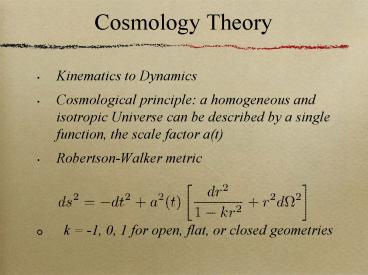Cosmology Theory - PowerPoint PPT Presentation
1 / 9
Title: Cosmology Theory
1
Cosmology Theory
- Kinematics to Dynamics
- Cosmological principle a homogeneous and
isotropic Universe can be described by a single
function, the scale factor a(t) - Robertson-Walker metric
- k -1, 0, 1 for open, flat, or closed
geometries
2
Friedmann Equations
- Combine R-W metric and General Relativity to give
the equations of motion for a(t)
Newtons Law of Gravitation
Conservation of Energy
? - Energy density of the Universes
constituents p - Pressure of the Universes
constituents
Acceleration
3
Normal vs Strange
- Solve Friedmann Equations depending on what the
Universe is made of (k0)
Non-relativistic matter
Radiation
Dark Energy
Cosmological Constant w-1
4
Universe Constituents Dynamics
By measuring a(t), we can determine the
constituents of the Universe, their relative
amounts, and properties of the dark energy.
5
Measuring Universes History and Fatewith
Standard Candles
6
SNAP Telescope
- 2-m primary aperture, 3-mirror anastigmatic
design. - Provides a wide-field flat focal plane.
7
Instrumentation Imager
A large solid-angle camera (0.7 square degrees)
provides multiplexed supernova discovery and
followup. Covers wavelength region of interest,
0.35- 1.7 microns. Fixed filter mosaic on top
of the imager sensors. 3 NIR bandpasses. 6
visible bandpasses. Coalesce all sensors at one
focal plane. 36 2k x 2k HgCdTe NIR sensors
covering 0.9-1.7 µm. 36 3.5k x 3.5k CCDs
covering 0.35-1.0 µm.
CCDs Guider HgCdTe
Spectrograph
Spectr. port
rin6.0 mrad rout13.0 mrad rin129.120 mm
rout283.564 mm
8
Instrumentation Imager
0.7 square degrees 9 passbands 0.35-1.7 microns
REU program, N.A.Sharp/NOAO/AURA/NSF
9
Spectrograph
Slicer Mirror Array
Telescope Focal Plane
Telescope
- Data cube
- Reduces pointing accuracy requirement
- Simultaneous SNe and host galaxy spectra
- Internal beam split to visible and NIR.
?





![Download Book [PDF] Hawley, J: Foundations of Modern Cosmology PowerPoint PPT Presentation](https://s3.amazonaws.com/images.powershow.com/10050367.th0.jpg?_=20240607117)

























